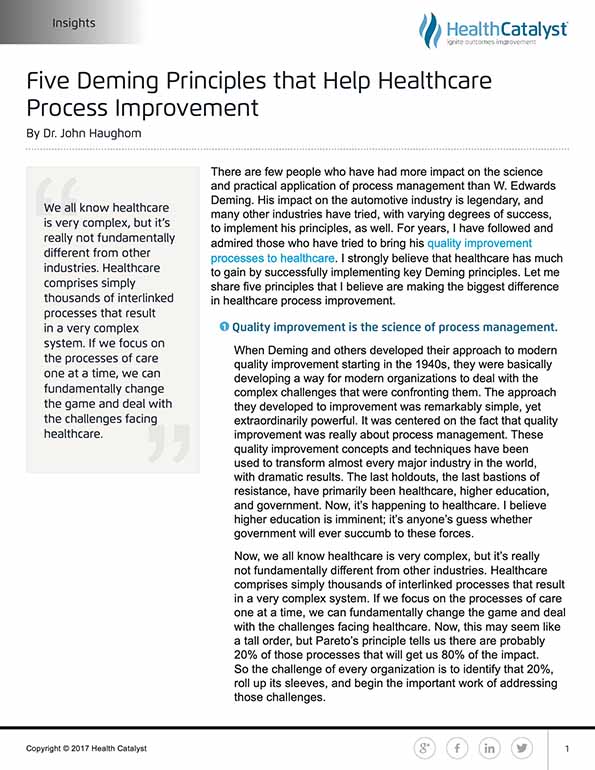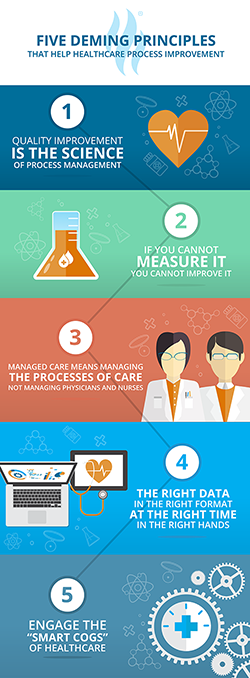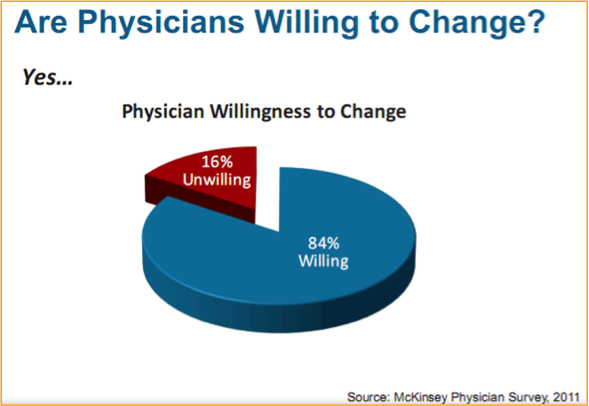Dr. John Haughom explains 5 key Deming processes that can be applied to healthcare process improvement. These include:
1. quality improvement as the science of process management
2. if you cannot measure it, you cannot improve it
3. managed care means managing the processes of care (not managing physicians and nurses)
4. the importance of the right data in the right format at the right time in the right hands, and
5. engaging the “smart cogs” of healthcare.



Few people have had more influence on the science and practical application of process management than Dr. W. Edwards Deming. His impact on the automotive industry is legendary, and many other industries have tried with varying degrees of success to implement his principles as well. For years I have followed and admired those that have tried to bring his quality improvement processes to healthcare. I strongly believe that healthcare has much to gain by successfully implementing key Deming principles. Let me share five principles that I believe can make the biggest difference in healthcare process improvement.
When Deming and others developed their approach to modern quality improvement in the 1940s, they were basically developing a way for modern organizations to deal with the complex challenges that were confronting them.
The approach they developed to improvement was remarkably simple, yet extraordinarily powerful. It’s centered on the fact that quality improvement is really about process management. These quality improvement concepts and techniques have been used to transform almost every major industry in the world with dramatic results. The last holdouts, the last passions of resistance, are primarily healthcare, higher education, and government. Now, it’s happening to healthcare. I believe higher education is imminent; it’s anyone’s guess whether government will ever succumb to these forces.
Now, we all know healthcare is very complex, but it’s not fundamentally different from other industries. Healthcare simply consists of thousands of interlinked processes that result in a very complex system. If we focus on the processes of care one at a time, we can fundamentally change the game and deal with the challenges facing healthcare. Now, this may seem like a tall order, but the Pareto principle tells us that there are probably 20 percent of those processes that will get us 80 percent of the impact. So, the challenge of every organization is to identify that 20 percent, roll up their sleeves, and begin the important work of addressing those challenges.
Deming clearly understood the importance of data. Meaningful quality improvement must be data-driven. This is particularly true for quality control in healthcare. You’re basically dead in the water if you try to work with healthcare providers and you don’t have good data. I think everybody recognizes that.
Deming said, “In God we trust…and all others must bring data.” I love this quote because it reflects that reality. I’ve had physicians during my career tell me pretty much the same thing, only they’re not quite so polite. They basically say, “Dr. Haughom, John, get lost! Bring the data. And then we’ll decide if we believe it.” So, data is critical if we’re going to have a meaningful impact in healthcare.
An important application or clarification of a Deming principle was put forward by my good friend, Dr. Brent James. Managing care means managing the processes of care. It does not mean managing physicians and nurses. What James said is very true. One of the big mistakes made in the 90s with the managed care movement was naively thinking that managing care meant telling physicians and nurses what to do. The reality is that you need to engage clinicians in the process because they understand the care delivery process and they are best equipped to figure out how to improve the process of care over time. And for this reason, I strongly believe that these changes will, in fact, ultimately be very empowering for all clinicians who try to get involved.
If clinicians are going to manage care, they need data. They need the right data delivered in the right format, at the right time, and in the right place. And the data must be delivered into the right hands—the clinicians involved in operating and improving any given process of care.
If quality improvement is going to work in healthcare—if we are going to realize value—it means we must engage clinicians. To use Deming’s term, clinicians are healthcare’s so-called “smart cogs.” They are the frontline workers who understand and own the processes of care. And as I said in an earlier slide, we’re very fortunate in healthcare because we have a workforce dominated by clinicians who are extraordinarily committed, very intelligent, and highly educated.
But we live in a pristine time. I once received from an email from a fellow physician leader at a leading national delivery system. I’m going to withhold the name of the delivery system, but I can tell you that if you ask knowledgeable people to list of top 10 delivery systems in the country, almost everyone would put this organization on their list. Despite that, this physician wrote to me lamenting how difficult it was for him to get his peer physicians to see a new future. And in his email, he succinctly described the problem by saying that his physicians were “historically encumbered and demoralized.” And I love the succinctness of his description because what he is basically saying is they’re clinging to the past and are demoralized because they don’t see a new future. And in that short phrase, this very excellent physician leader pretty much encapsulated the problem and points us towards the solution.

A 2011 McKinsey survey clearly demonstrates that the majority of physicians are, in fact, willing to change. McKinsey more than 1,400 US physicians and found that 84 percent said they were willing to change if a reasonable course and argument could be made that change was necessary.
So, how do we reconcile this? I believe we need to help clinicians figure out how to give up the past by helping them see a new future and help them understand their role in creating and sustaining that new future. In fact, I believe one can make a very strong case that the future will be very empowering for clinicians of all types if we can successfully inform them, engage them, and inspire them. Applying these key Deming principles to healthcare process improvement can help every healthcare organization show the workforce why change is necessary, what they need to understand to participate in meaningful change, and what success will ultimately look like.
From population health management to value-based care, healthcare providers face a quagmire of reimbursement schemes and quality initiatives, each requiring precise analysis of clinical, financial, and patient data. Yet to get there, they must unravel a Gordian knot of diverse information systems that cannot communicate with each other and that separately lack the data needed to succeed. The explosion of information from wearables, mobile phones, genomics, and other sources outside the traditional healthcare sphere is exacerbating these problems while also enabling personalized healthcare and management as never before, assuming organizations can manage the transformation.
Clinical and financial decision support at the point of care is almost nonexistent in healthcare, restricted to a few pioneering organizations that can afford the engineering and informatics staff to implement and maintain it. With the Health Catalyst® Data Operating System (DOS™), this kind of decision support is affordable and effective, raising the value of existing electronic health records and making new software applications possible.
In short, quality and cost improvements require intelligent use of linked financial and clinical data coupled with education for multi-disciplinary teams who are driving process improvements. DOS offers the ideal type of analytics platform for healthcare because of its flexibility. DOS is a vendor-agnostic digital backbone for healthcare. Using DOS, teams will be able to apply the principles outlined in this piece and, ultimately, achieve high-value results.
Would you like to use or share these concepts? Download this presentation highlighting the key main points.